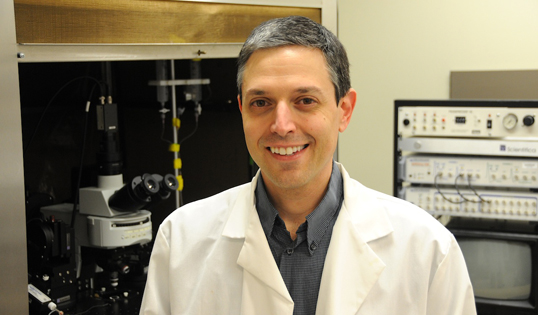
Andrew R. Tapper, PhD, and colleagues have identified the region of the brain in which nicotine withdrawal symptoms originate.
Headaches, anxiety, irritability—these and other symptoms of nicotine withdrawal can significantly deter smokers from being able to kick the habit. Now, in what may be a significant step toward alleviating those symptoms, UMass Medical School neuroscientist Andrew R. Tapper, PhD, and colleagues have identified the region of the brain in which they originate.
“We were surprised to find that one population of neurons within a single brain region could actually control physical nicotine withdrawal behaviors,” said Dr. Tapper, associate professor of psychiatry and interim director of the Brudnick Neuropsychiatric Research Institute at UMMS.
The Tapper lab discovered that physical nicotine withdrawal symptoms are triggered by activation of GABAergic neurons (neurons that secrete GABA, the brain’s predominant inhibitory neurotransmitter), in the interpeduncular nucleus, an area deep in the midbrain that has recently been shown to be involved in nicotine intake. Their study was published in the Dec. 2 issue of the journal Current Biology.
“Most of the work in the field has been focused on the immediate effects of nicotine, the addictive component in tobacco smoke, on reward circuits in the brain,” Tapper explained. “But much less is known regarding what happens when you take nicotine away from someone who has been smoking for a long time that causes all these terrible withdrawal symptoms. Our main goal was to understand what brain regions are activated—or deactivated—to cause nicotine withdrawal symptoms.
They did this through a series of experiments performed in mouse models with sophisticated neurochemistry and brain imaging methods, including recently developed optogenetics techniques in which specific neurons can be activated by light.
Most surprising was their discovery that nicotine withdrawal symptoms can be activated or deactivated independent of nicotine addiction. “When we activated the GABAergic neurons in the interpeduncular nucleus, mice suffered withdrawal symptoms even if they had no previous nicotine exposure,” Tapper noted.
These findings are promising because existing treatments intended to help people quit smoking are not always effective. “There are very few treatments to help people quit smoking,” Tapper said. “If you can dampen the activity of this brain region chemically during nicotine withdrawal then you would hopefully be able to help someone quit smoking because you could reduce some of the withdrawal symptoms that they are experiencing.”